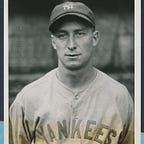Monday, May 2, 1927: Washington, D.C.
“Urban and Eddie”
 Paul Gallico is a writer for the New York Daily News. He’s about my age and a swell guy, and probably the best writer of the reporters who cover the team.
Paul Gallico is a writer for the New York Daily News. He’s about my age and a swell guy, and probably the best writer of the reporters who cover the team.
Gallico’s always trying to get inside our heads, in a good way, in a sincere attempt to figure out what we’re really thinking and feeling. Unfortunately for him, ballplayers are not an overly reflective bunch. But that doesn’t stop him from creatively trying to connect.
Last night on the train while the two of us were killing time playing gin, out of the blue Gallico asked me, “Which teammate do you admire the most?” It was the first time I’d ever been asked that question, and my immediate response was to avoid answering it — not because I couldn’t pick one teammate, but because I couldn’t tell him the truth.
I admire Urban Shocker more than any man I’ve ever met. But I’ve promised Urban and Miller Huggins, and Eddie Bennett, that I won’t tell anybody why.
 Urban is on his second tour with the Yankees. He played two seasons before Huggins took over in 1918, and quickly traded him to the St. Louis Browns. Hugg now calls it the biggest mistake of his baseball career, and it’s hard to argue with him.
Urban is on his second tour with the Yankees. He played two seasons before Huggins took over in 1918, and quickly traded him to the St. Louis Browns. Hugg now calls it the biggest mistake of his baseball career, and it’s hard to argue with him.
Two years after the trade, Urban Shocker was probably the best pitcher in the league outside of Walter Johnson. Pitching for the lowly Browns, Urban had four 20-win seasons in a row, winning 27 games in 1921, which was a third of the Browns’ wins that year, and winning 24 games in 1922. It took Hugg seven years to get Urban back, which he finally did in 1925, trading three pitchers for him, including “Bullet Joe” Bush.
Shock is one of the last spitball pitchers in the game. When they outlawed the spitter in 1920 they grandfathered in the major leaguers who already threw it. There are still days when Shock pitches that you wonder how any human being could produce that much saliva.
Off the mound, Shock is perhaps baseball’s biggest student. He not only studies the opponent’s hitters from the bench, he also reads as much about them as possible. Every day, at home and on the road, Shock buys as many newspapers as he can and spends a considerable amount of time each day checking out the boxscores to see how certain hitters are doing against different pitchers. He then makes notes in a journal that he keeps.
Shock knows what each pitcher in the league likes to throw, so by carefully investigating the boxscores and game summaries, he gleans information about the outcome of practically every pitcher-hitter matchup. This gives him insight, for example, into how well a particular player is hitting curveball pitchers.
Reading the papers and taking copious notes, Urban also gets a sense of which batsmen are hot. Whereas most reporters and fans only notice when an out-of-town player goes on a 10-game tear, by studying the papers the way a railbird studies the Daily Racing Form, Shocker can spot players who’ve had a couple of mini-hot streaks over the course of a two-week period. And by reading the out-of-town papers — four or five from each city — Shock also gets a sense from the writers and the columnists of the temperature of each team and its players.
Urban’s late-night reading companion on the road and on trains is Eddie Bennett.
 Eddie’s life story is something that only Charles Dickens could have dreamed up — if Dickens had been a baseball fan.
Eddie’s life story is something that only Charles Dickens could have dreamed up — if Dickens had been a baseball fan.
Bennett’s chances of being a Yankee, or even a sandlot ballplayer, were wiped out when he suffered a horrible spinal injury while still an infant, back around 1904 or ’05. The accident left Eddie deformed with a hunched back, and it retarded his growth to the point where today he is a dwarf. His uncertain future was made even more bleak at the age of 15 when both his parents died in the influenza epidemic of ’18, leaving him an orphan on the streets of Brooklyn, New York.
The following year, Eddie began his Dickensian journey out of squalor and into the major leagues:
While attending a game at the Polo Grounds, the deformed urchin somehow caught the eye of Happy Felsch, the White Sox’s extremely superstitious center fielder. Over the course of that weekend’s series, Felsch, a primitive in cleats, became convinced that the hunchbacked dwarf was good luck. Egged on by Eddie Cicotte, the ChiSox star pitcher, Felsch urged his manager to make Eddie the White Sox team mascot. The next day, when the ChiSox left town, they packed the 16-year-old orphaned dwarf on the train with them and brought him back to Chicago.
Eddie’s good luck lasted the rest of the season, and the White Sox won the American League pennant. But just before the World Series, Felsch, Cicotte and six of their teammates traded Eddie’s good luck for Arnold Rothstein’s green cash, and then threw the World Series to the Reds.
After the Series, Eddie moved back to Brooklyn. Unemployed, he hung around Ebbets Field where he soon convinced a bunch of the Robins that his won-loss record as a mascot with the White Sox proved he was a legitimate talisman. Naturally, with Eddie aboard as their new mascot, Brooklyn won the National League pennant that year.
The Robins lost the World Series to the Indians, but Eddie’s legend only grew. It seems many of the Brooklyn players blamed their loss on the Robins’ management, which was too cheap to send Eddie to Cleveland. That pissed off the dwarf, who put the hoodoo on the Robins when they were out of town. As a result, many Brooklyn players believe, the Robins lost all of their road games against Cleveland.
Not only did most of the Robins come to believe in the “curse of the dwarf,” but so did a few of the 1920 Yankees, who convinced Ed Barrow and Huggins to hire the still pissed off Eddie to be the Yankees mascot for the 1921 season. Naturally, those ’21 Yankees went on to win the American League pennant — the first in the Yanks history, and the first of three in a row — cementing little Eddie’s place as the greatest good luck charm in all of baseball.
(Personally, I think George Herman Ruth might be a stronger talisman than Eddie. In ’21, Eddie’s first year on the Yanks, the Babe hit 59 home runs — still more than any man has ever hit, and probably ever will — then in ’24 he had 46 homers, and last year he slammed 47 and had 153 RBIs. That’s a lot of good luck.)
 Since ’21, Eddie has been in a Yankee uniform at home and on the road, serving not only as our team mascot but also as our bat boy. Six years and four pennants after his arrival, there’s hardly a player on the team who will let anyone other than Eddie hand him his bat before he walks to the plate.
Since ’21, Eddie has been in a Yankee uniform at home and on the road, serving not only as our team mascot but also as our bat boy. Six years and four pennants after his arrival, there’s hardly a player on the team who will let anyone other than Eddie hand him his bat before he walks to the plate.
Eddie’s also become a personal good luck charm for the Babe—actually, something more than that. Before every one of Ruth’s at bats, Eddie kneels with him in the on-deck circle, and they watch the game together — two orphans surrounded by tens of thousands of fans. Sometimes they chat. Sometimes they’re silent. Almost always, Ruth has his giant arm draped over the dwarf’s back.
After the Babe hits a home run, Eddie is always there to greet him at home plate.
And yet, as close as Eddie is to Ruth on the field, off the field he is consummately devoted to Urban Shocker.
And that’s because Urban is dying.
No one in the organization, except for Eddie, Miller Huggins and I know anything about it — and I only know because one night last season in Detroit, as I was walking in the hallway back to my hotel room, Eddie came flying out of the room he and Urban were sharing, frantically looking for help. Shocker was having trouble breathing and Eddie needed someone to help lift Urban up in his bed.
Urban, I learned that night, has a terminal heart condition that requires him to sleep sitting up, otherwise his lungs will fill with fluid and he’ll contract pneumonia, or worse. Urban confided this to Huggins last year, and Hugg wanted someone to room with him who could keep a secret, and wasn’t ever going to get traded, so he quietly assigned Eddie the job of nursing Urban at night in our hotels and on the rails.
On trains, Eddie rides in the berth next to Urban, and on the road they share a hotel room. At night, after we’re all asleep, every couple of hours Eddie gets up to be sure that Shocker’s sitting up properly. If Urban’s not fully upright, Eddie will gently nudge him awake. Eddie’s too little and hasn’t the strength to move him on his own.
How Urban has the stamina to pitch as well as he does — not to mention the courage — is beyond my comprehension. Perhaps poring over all those newspapers helps keep his mind off his pending mortality. I don’t know. He and I have never discussed it. I do know from Eddie that there has only been one time in the last year that Urban’s not felt well enough for Huggins to put the ball in his hand. Huggins told the team it was because Shock had a chest cold.
Sometimes late at night on the road I’ll stop in the hotel hallway outside their door and listen for a few minutes. Occasionally I can hear Eddie reading the papers aloud, so that Urban can rest his eyes and drift asleep. It happened the other night in the Statler Hotel, in Boston.
“Sad Sam Jones tortured the Indians on Wednesday, Shock. He gave up 13 hits, but he still won 4–2 against ’em. Luke Sewell sure had Sad Sam figured out, though — he went three for five. Sewell had two singles and a double, Shock. He also scored a run. I’ll mark that in the book for you ….”
As I stood listening outside their hotel door, I thought about the randomness of it all — a great athlete like Urban being cared for by someone trapped inside a broken body — and how if it wasn’t for baseball, where would Eddie be?
In truth, Eddie would probably be in a freak show on Coney Island, being stared at by children his own size, and by adults who would have no other use for him. But somehow Eddie’s fantastical journey has delivered him to the Yankees, where he’s found a home, and real meaning to his life.
 Urban Shocker’s secret is something I’ll hold onto until the day he finally succumbs. Maybe longer.
Urban Shocker’s secret is something I’ll hold onto until the day he finally succumbs. Maybe longer.
And that’s why, on our train to Washington last night, when Gallico asked me, “Which Yankee do you admire the most?” I simply replied, “Gin,” laid down my cards, and pointed out that our train was pulling into Union Station.
